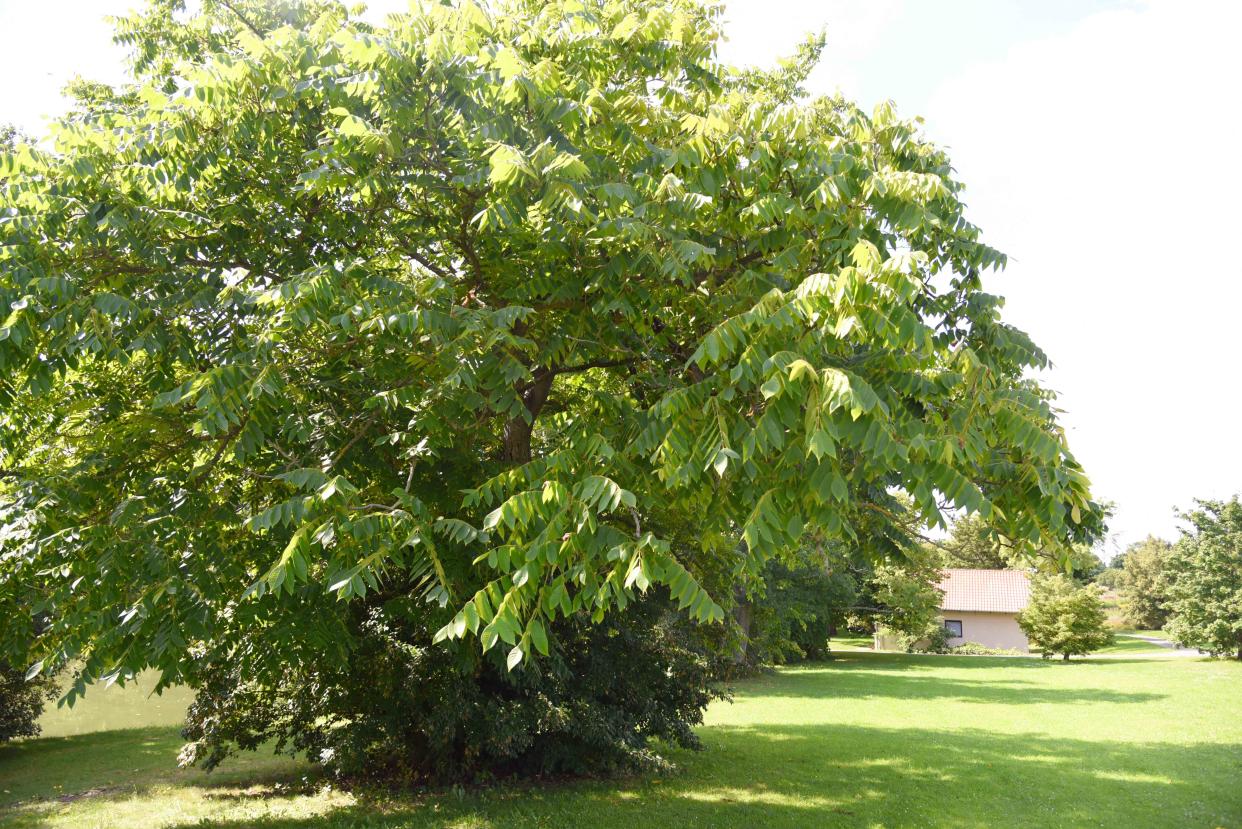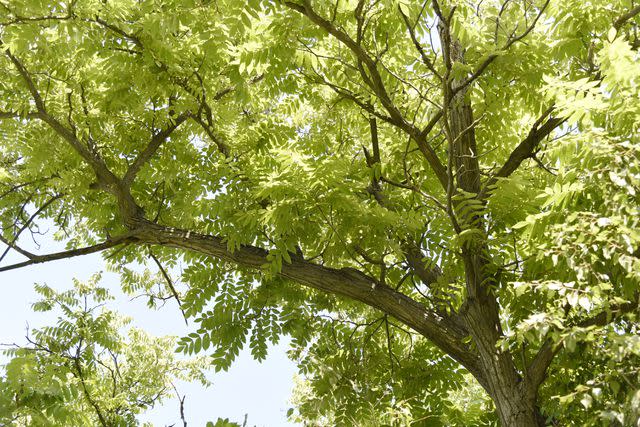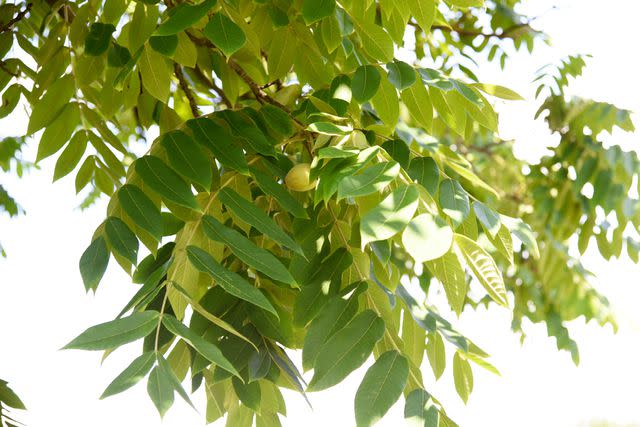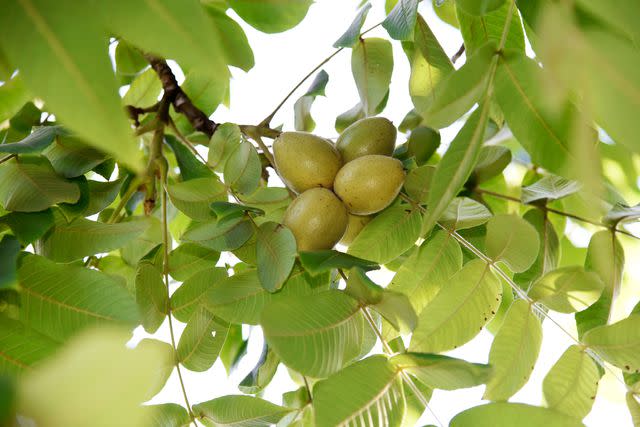How to Grow and Care for Butternut Tree

The Spruce / Evgeniya Vlasova
The butternut tree is one of the hardiest nut trees. Its native range stretches from the entire northeastern United States into southeastern Canada. The tree was once highly valued for its nuts with a rich, sweet, buttery flavor, its attractive light golden wood, and its broadly rounded crown that provides shade in the landscape. Yellowish-green flowers appear in late spring, giving way to the fruits that ripen into nuts in fall. Nowadays, however, butternut trees are increasingly rare in the wild, and they are not commonly found at nurseries. The reason for that is the susceptibility of the tree to a deadly fungal disease known as butternut canker.
The tree can be planted in the spring or fall. The tree grows fairly slowly, adding less than 12 inches per year. It can live up to 75 years.
Common Name | Butternut tree, white walnut tree |
Botanical Name | Juglans cinerea |
Family | Juglandaceae |
Plant Type | Tree |
Mature Size | 40–60 feet tall and wide |
Sun Exposure | Full |
Soil Type | Moist, well-drained |
Soil pH | Acidic, neutral |
Bloom time | Spring, summer |
Flower Color | Yellow, green |
Hardiness Zones | 3–7 (USDA) |
Native Area | North America |
Butternut Tree Care
Butternut is quite a broad tree, growing as much as 60 feet wide, so it should be planted in an area with plenty of space and full sun. Also keep it away from garden areas and plantings because just like black walnut trees, butternut trees emit juglones into the soil. Because the tree has deep taproots, it is quite hard to move butternuts once they are established so pick the location carefully.
In terms of maintenance, the butternut tree is easy to care for. Pruning is essential—the crown can hang quite low if the tree is not kept pruned. Monitoring the tree for butternut canker is vital. Even if you have planted a hybrid butternut, or the tree’s location is isolated in a landscape setting far from natural stands of butternut, it is important to regularly inspect the tree for signs of the butternut canker disease that has ravaged the species.

The Spruce / Evgeniya Vlasova
Light
Butternut trees need full sun; they do not tolerate shady conditions. The tree is best grown in open spaces far away from other trees and plants.
Soil
The tree does best in rich soils that are fairly moist and slightly acidic, with a pH between 6.8 and 7.2.
Water
This tree does best with consistent moisture but established trees can tolerate some drought.
Temperature and Humidity
Butternut trees are very hardy trees that can be grown down to USDA zone 3. High humidity in combination with dense canopies and poor air circulation leads to a higher incidence of the deadly butternut canker.
Fertilizer
If you planted the tree in rich soil, there is no need to fertilize the tree.
Types of Butternut Tree
Planting a hybrid butternut, which has better resistance to the disease, increases your chances of getting the tree to the stage when you can harvest its delicious nuts.
There are no named cultivars of J. cinera, but there are hybrids with varying degrees of resistance to butternut canker. Butternut trees have been crossed with Japanese walnut (J. ailantifolia) and heartnut (J. mandshurica var. cordiformis). Hybrids between butternut and heartnut are called Buartnut, or short, Buart. A popular Buartnut cultivar is ‘Mitchell’, which is self-fertile.

The Spruce / Evgeniya Vlasova
Pruning
Keeping your butternut tree well-pruned from when it is still young is important not only for aesthetical reasons. Pruning opens up the center of the tree to light and air. Dense foliage, especially in humid conditions, is a breeding ground for butternut canker and other diseases.
If signs on cankers appear on any branches, prune them immediately down to about 8 inches below the affected areas; this may prevent the disease from spreading. Also cut out any thin, weak branches and eliminate sharp V-shaped crotches, keeping those with a U shape.
Keep the crown raised above the ground by pruning away downward-facing branches from the lower limbs. Without such pruning, the crown may grow too low to walk beneath or mow around the tree. Don't remove more than one-fourth of the tree's crown at any one time, as this weakens the tree and makes it more susceptible to disease. The best time for pruning is towards the end of the dormant season in late winter.
Propagating Butternut Trees
Due to the severity of butternut canker, it is not recommended to propagate just any butternut tree from cuttings or nuts, only to see it succumb to the disease within a few years. If you want to plant a butternut tree, start with a hybrid sapling from a nursery because it has better diseases resistance. Note that if you already have a hybrid butternut tree growing in your yard, propagating it requires cross-pollination or grafting with a second species, a process that is better left to trained horticultural personnel at a nursery.

The Spruce / Evgeniya Vlasova
Potting and Repotting Butternut Trees
Because of its size, butternut tree is not suitable to be grown in pots or containers.
Overwintering
Butternut is a hardy tree that does not need any winter protection.
Common Pests and Diseases
Butternut trees are susceptible to various insects, including bark beetles, caterpillars, borers, and lace bugs. The most serious, deadly threat to the tree, however, comes from butternut canker (Sirococcus clavigignenti-jug-landacearum). This fungal disease has wreaked havoc on the native butternut population and killed has killed up to 80% of the butternut trees in some states. As a result, the tree has been placed on the endangered species list in some parts of the United States. Unfortunately, there is no cure for the disease. Affected trees usually die within a few years.
The infected areas are most noticeable on large branches or tree trunks, causing long fissures and distortions in the bark. Sometimes several infected areas grow together. Smaller infected areas can form around scars, such as pruning cuts. Look for sunken and black spots, with white margins and surrounded with what looks like crimped bark. Eventually the branches with canker die because the canker cuts off the supply of nutrients and water. Even after a branch has died, the spores are spread by rain to other parts of the tree. The canker produces spores during the entire growing season.
The spores are transmitted from infected trees through rain splash, insects, and wind. That’s why it is crucial that you plant a butternut tree as isolated as possible in the landscape. Often, wounds, such as from pruning, serve as entry points for the fungus.
Make sure to regularly inspect the tree and prune away any suspicious branches as soon as you spot them. Don’t forget to sanitize your tools to prevent spreading the spores from one branch to another. Wipe your pruners with a 10% bleach solution (one part bleach to nine parts water) after each cut.

AnjoKanFotografie / Getty Images
Common Problems with Butternut Trees
Like black walnut, the butternut tree produces juglones. These chemicals are toxic to other plants and can kill them or stunt their growth. The juglones in the soil reach as far as the dripline of the tree. To avoid problems, do not plant a butternut tree near other plantings.
Frequently Asked Questions
What is the difference between a black walnut tree and a butternut tree?
Black walnut trees are a different species from a butternut tree. Butternut looks a lot like its close relative, the black walnut, but it is smaller. The bark is more gray and less fissured than the black walnut, and the nuts are more oval and less rounded than the fruit of the black walnut.
Are butternut trees messy?
Butternut trees can be messy. The compound leaves of the butternut tree are large, 10 to 20 inches long. The dropped leaves in the fall, as well as the nut drop, can be messy.
Do I need to plant two butternut trees to get nuts?
Butternut trees are self-fertile but for best pollination, if you want the nuts, it is recommended to plant two trees. The butternut is monoecious, which means that it grows separate male and female flowers during its bloom in the spring. These flowers are small and insignificant. Its male flowers are a light yellow-green, while its female flowers are lighter yellow and produce the tree’s edible nuts in the fall.
Are butternuts valuable?
Butternuts are sweet and buttery and a delicacy, but they are work. Just like black walnuts, they are messy to harvest, as the black tannins in the nutshell leave pesky stains. The nutshells are hard to crack; they require a special nutcracker for hard-shelled nuts. Also, you will compete with deer, squirrels, and birds for the nuts.
